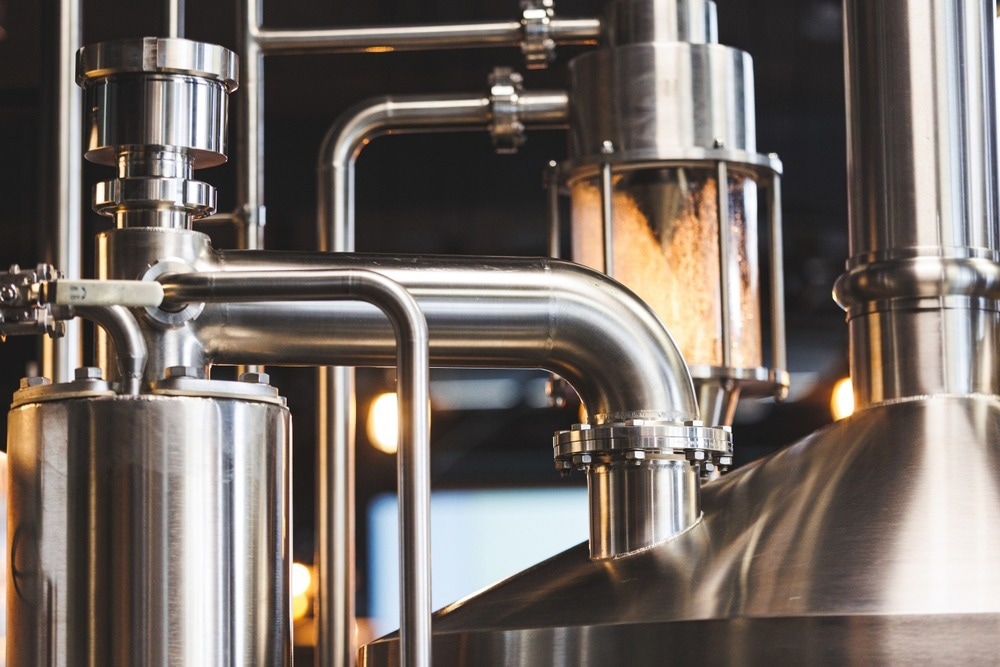Whether at a small local craft brewer or in a massive factory owned by an international conglomerate, commercial beer brewing requires precision and strict quality control at every step of the process. Modern brewing operations rely on pH sensors to ensure beer production meets or surpasses expectations.

Image Credit: Rokas Tenys/Shutterstock.com
As anyone who has taken a brewery tour can tell you, the brewing process begins with malted barley being milled and then mix with hot water to create what's called a ‘mash’. The hot water converts starches in the malted barley into sugars to create ‘wort’. This liquid is strained and brought to a boil. Hops are then added to add bitterness, flavor and aroma.
The hopped board is then cooled and aerated before yeast is added. The brewer’s yeast metabolizes sugars in the wort to create alcohol, carbon dioxide, and other products. The resulting beer is often filtered and carbonated before it is bottled or kegged.
Monitoring pH at Different Stages of the Brewing Process
Precise testing throughout the entire process is essential to producing good beer. In fact, testing should begin before the actual process. Incoming raw materials must be tested to ensure quality and this includes checking the pH of water that will be used for brewing.
Acids are released throughout the brewing process, and the water used should have a certain level of alkalinity that can offset these acids. Checking the pH of incoming water is also critical for companies with multiple breweries in different locations. Because the composition of water can be different at different sites, checking and adjusting pH must be part of standardization efforts.
It is also important to test pH throughout the process because it plays a major role in yeast activity and various chemical reactions. Tracking the pH of a brew is a simple but effective way to track quality and monitor the process. During mashing, pH levels should decrease to between 5.2 and 5.6. Often, acid must be added to reduce the pH to the desired levels, and this is typically done by adding lactic acid. This acidic pH translates to a number of key benefits, including:
- Increased enzyme activity that converts more starches to sugars.
- Increased yeast activity and inhibition of bacteria growth.
- Greater extraction of hop aromas and flavors.
- Greater clarity in the final product.
- Better flavor and shelf life.
Monitoring pH is also critical to other parts of the beer production process to ensure quality. During filtration, pH is monitored to ensure a beer remains clear and free of haze, which often forms at pH levels slightly higher than 4. At higher pH levels, a beer is more prone to forming undesirable levels of foam. During packaging, pH is checked on the last time for quality control.
It is also important to test the pH of any wastewater that has been produced to ensure that a brewery is responsibly discharging this waste material. Municipal wastewater plants cannot handle the high-strength wastewater produced from brewing operations. Therefore, it is against the law to simply discharge wastewater into a local sewage system.
The first step in a brewery’s wastewater treatment process is neutralizing pH. Wastewater cannot be too acidic or basic before it is discharged into a sewer system, or else a brewery can receive a fine. The next steps involve removing suspended solids, biological oxidation demand (BOD), and chemical oxidation demand (COD). Not taking these steps can result in a brewery being hit with “strength charge fees” for releasing wastewater that is too potent.
Benefits of Real-Time pH Monitoring
Many modern brewing operations use real-time pH monitoring to take a more proactive approach to their processes. This is typically done with automated pH sensors that monitor levels in real-time throughout the entire process. Real-time monitoring translates to a number of key benefits over using a more reactive approach to pH testing.
On-the-Fly Adjustments
Mistakes will happen and real-time pH monitoring allows a brewer to catch these mistakes before they completely ruin a batch of beer. On-the-fly adjustments also help maintain consistent quality.
Optimal Fermentation
Live monitoring using pH sensors allows brewers to create the optimal acidity for fermentation. The result is more efficient fermentation and desirable flavors.
Better Use of Analytics
Every industry collects and uses data, including the brewing industry. Real-time monitoring allows brewers to use their data analysis in a more proactive manner.
The use of real-time pH monitoring does require additional maintenance and sensor calibration. Getting the most out of an investment in modern pH sensors also requires systems for data collection and analysis. Breweries looking to invest in real-time pH monitoring should use best practices for maintenance and calibration.
Conclusion
Breweries that invest in automated pH sensors can see massive returns. These sensors empower staff members and improve quality. They only require a bit of additional work and the adoption of a few new practices. Real-time pH monitoring gives brewers another tool they can use to optimize the products they already produce and research new beer recipes.
Resources and Further Reading
BrewOps Solutions. (2023). Optimizing Craft Beer Fermentation: The Power of Real-Time pH Monitoring [Blog post]. Retrieved from https://brewops.com/blog/optimizing-craft-beer-fermentation-the-power-of-real-time-ph-monitoring/. Accessed on October 27.
Thermo Fisher Scientific. (2022). pH and beermaking. Available at: https://assets.thermofisher.com/TFS-Assets/LPD/Product-Guides/eBook-pH-Beermaking-EN.pdf
Smith, B. (2015). Mash pH and Why It Matters for All Grain Beer Brewing. BeerSmith Brewing Blog. Available at: https://beersmith.com/blog/2015/05/07/mash-ph-and-why-it-matters-for-all-grain-beer-brewing.
Disclaimer: The views expressed here are those of the author expressed in their private capacity and do not necessarily represent the views of AZoM.com Limited T/A AZoNetwork the owner and operator of this website. This disclaimer forms part of the Terms and conditions of use of this website.